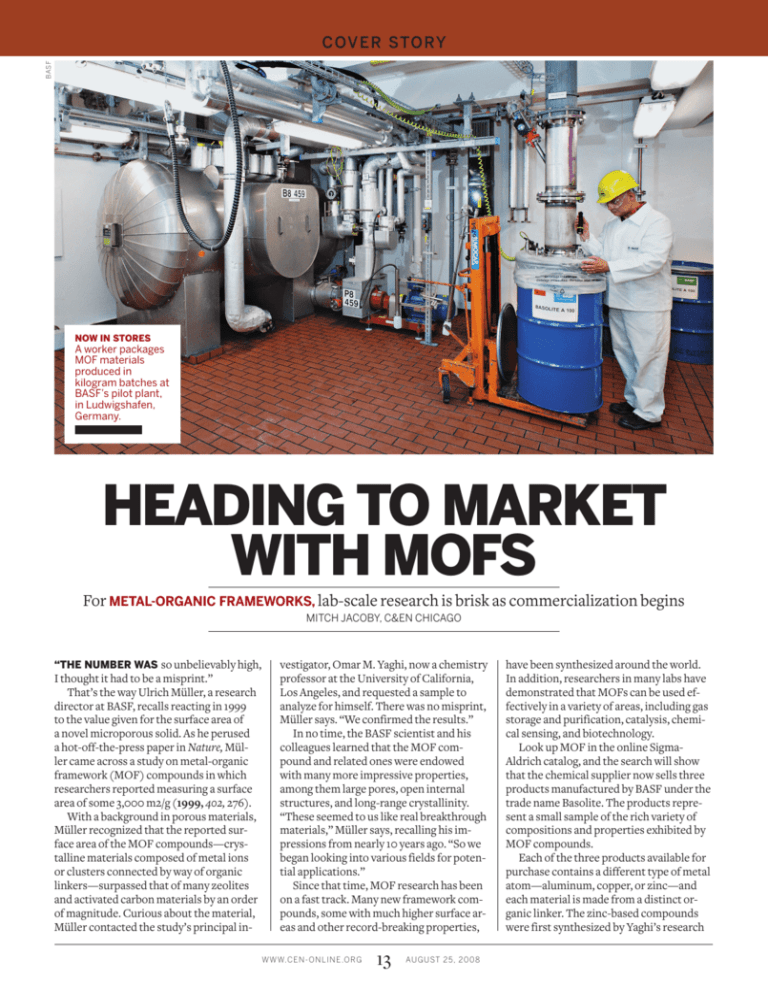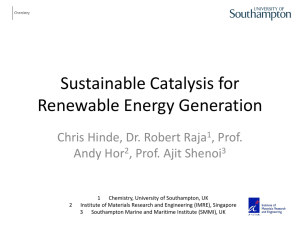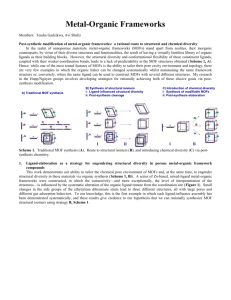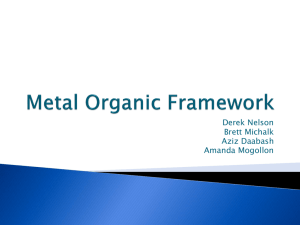Read the C&EN article here.
advertisement

BAS F cover story Now In Stores A worker packages MOF materials produced in kilogram batches at BASF’s pilot plant, in Ludwigshafen, Germany. Heading To Market With MOFs For Metal-Organic frameworks, lab-scale research is brisk as commercialization begins Mitch Jacoby, C&EN Chicago “The number was so unbelievably high, I thought it had to be a misprint.” That’s the way Ulrich Müller, a research director at BASF, recalls reacting in 1999 to the value given for the surface area of a novel microporous solid. As he perused a hot-off-the-press paper in Nature, Müller came across a study on metal-organic framework (MOF) compounds in which researchers reported measuring a surface area of some 3,000 m2/g (1999, 402, 276). With a background in porous materials, Müller recognized that the reported surface area of the MOF compounds—crystalline materials composed of metal ions or clusters connected by way of organic linkers—surpassed that of many zeolites and activated carbon materials by an order of magnitude. Curious about the material, Müller contacted the study’s principal in- vestigator, Omar M. Yaghi, now a chemistry professor at the University of California, Los Angeles, and requested a sample to analyze for himself. There was no misprint, Müller says. “We confirmed the results.” In no time, the BASF scientist and his colleagues learned that the MOF compound and related ones were endowed with many more impressive properties, among them large pores, open internal structures, and long-range crystallinity. “These seemed to us like real breakthrough materials,” Müller says, recalling his impressions from nearly 10 years ago. “So we began looking into various fields for potential applications.” Since that time, MOF research has been on a fast track. Many new framework compounds, some with much higher surface areas and other record-breaking properties, www.cen-onlin e .org 13 August 2 5, 20 0 8 have been synthesized around the world. In addition, researchers in many labs have demonstrated that MOFs can be used effectively in a variety of areas, including gas storage and purification, catalysis, chemical sensing, and biotechnology. Look up MOF in the online SigmaAldrich catalog, and the search will show that the chemical supplier now sells three products manufactured by BASF under the trade name Basolite. The products represent a small sample of the rich variety of compositions and properties exhibited by MOF compounds. Each of the three products available for purchase contains a different type of metal atom—aluminum, copper, or zinc—and each material is made from a distinct organic linker. The zinc-based compounds were first synthesized by Yaghi’s research cover story “We’re witnessing explosive growth in metal-organic framework chemistry.” EcoFuel Worl d Tour group. The research group of Gérard Férey, a chemistry professor at the University of Versailles’ Lavoisier Institute, in France, prepared the aluminum-based material. BASF uses a novel method for preparing a copper compound. The catalog search also brings up a link to a Web page on which the chemical supplier has grouped together a number of organic reagents under the heading “linkers for metal-organic frameworks.” Aimed at researchers shopping for chemical building blocks from which to synthesize these microporous compounds, the list includes terephthalic acid, methyl imidazole, and other substances. The MOF compounds sold by Sigma-Aldrich are manufactured in a BASF pilot plant in Ludwigshafen, Germany, in 100-kg-per-day batches, Müller says. He notes that only a portion of the plant’s output is sold via Sigma-Aldrich and that BASF uses most of the material internally for various R&D projects. The word on the street in the research community is that industrial scientists in many companies are investigating framework compounds for use in purification, storage, and transportation of gases, among other applications. But most of those companies aren’t prepared to disclose many details about their research activities. “Shell has been executing R&D on metal-organic frameworks for a few years now,” says Herman P. C. E. Kuipers, regional manager for innovation and research at Shell Global Solutions, based in Amsterdam. That’s about it for details, though. All Kuipers would say is that the focus at the company is on discovering valuable applications for these “appealing new materials”— applications that make a real difference in existing and new technologies. He adds The MOF-enhanced system provided an overall driving range of more than 1,500 miles between fill-ups. “These materials are no longer just for academic use,” Müller stresses. Nonethethat “the wealth of new structures, the less, at the present time, the great majority very high surface areas, the large pores, the of the efforts in developing MOF materisurprising stability, and the ability to tweak als and applications—at least the ones the chemistry of the basic building blocks reported publicly—are indeed academic in are all good reasons to expect discoveries nature. And those efforts are progressing at relevant to a variety of activities at Shell.” a healthy clip. One area of interest to gas suppliers and “We’re witnessing explosive growth in the automobile industry is the use of the MOF chemistry,” says Mike Zaworotko, a porous compounds to store transportation chemistry professor at the University of fuels. The materials’ extreme surface areas South Florida, Tampa. In a broad literature coupled with their favorable energetics for search, Zaworotko notes that activity in the adsorbing gas opens the way to cylinders field has risen sharply in recent years, with filled with MOFs to store roughly twice as some 1,300 journal publications and more much gas as do standard cylinders, accordthan 25,000 citations just in 2007. ing to Müller. That sentiment is shared by Texas A&M That property played a key role in keepUniversity chemistry professor Hong-Cai ing German adventurer Rainer Zietlow (Joe) Zhou, who coorganized a MOF chemon the go last year during a six-month, istry symposium held last spring at the ACS 28,000-mile road trip fueled by natural gas. national meeting in New Orleans. “We deAiming to increase public awareness cided to run the symof the environmental benefits and posium all week long,” the feasibility of using that fuel in Zhou says. “And there On The Road German place of conventional transportation adventurer Zietlow still wasn’t enough poses in Egypt in fuels, Zietlow embarked on the Ecotime to accommodate November 2006 during Fuel World Tour, a journey through everyone who wanted his 28,000-mile driving 40 countries and five continents, in to present their work.” expedition in a naturalgas-fueled vehicle. The a Volkswagen Caddy that had been One particuvehicle was equipped optimized for natural gas combuslarly hot trajectory of with fuel tanks that tion. The van was outfitted with 13 were modified with MOF MOF-based research fuel tanks, some of them packed with compounds to increase deals broadly with their storage capacity. BASF MOFs, according to Müller. gas storage. Some of the work focuses on designing materials suitable for storing large quantities of hydrogen, with an eye toward fuel-cellpowered automobiles. A couple years ago, Yaghi and coworkers showed that one of their zinc-based materials, dubbed MOF-177, which has a surface area of more than 5,600 m2/g, can store 7.5% by weight of hydrogen at 77 K (J. Am. Chem. Soc. 2006, 128, 3494). Around the same time, UC Berkeley chemistry professor Jeffrey R. Long reported that a MOF compound contain- www.cen-onlin e .org 14 August 2 5, 20 0 8 Mix And Match With a large supply of organic linkers such as terephthalic acid (top) and triscarboxylates (one shown, bottom) readily available, an enormous number of framework compounds can be synthesized. O 1012). That value exceeds a key Department of Energy target for methane storage by 28%. In addition to storing valuable gases, MOF compounds can trap greenhouse gases, such as CO2, and various poisons. Working on that aspect of gas storage, Férey’s group at Versailles combined chromium trimers and carboxylate linkers to form two materials, MIL-100 and MIL-101, each of which is composed of cages of two sizes—roughly 2.5 and 3 nm and 3 and 3.5 nm, respectively. The team notes that both materials can store large amounts of gas, adding that MIL-101, which has a surface area of roughly 5,900 m2/g, exhibits a record CO2 capacity of 390 VSTP/V at 303 K and 50 bar (Langmuir 2008, 24, 7245). OH HO O Terephthalic acid O OH HO OH O O 1,3,5-Tris(4-carboxyphenyl)benzene r equest mor e at a di nfonow.org ing manganese ions can store 6.9 wt % of hydrogen—also at 77 K (J. Am. Chem. Soc. 2006, 128, 16876). Several factors besides surface area influence hydrogen uptake in MOF materials, Zhou says. Another critical property is the heat of adsorption, which is a measure of the strength of the interaction between hydrogen molecules and MOF surfaces. If the interaction is too weak, as is the case with most of today’s MOF compounds, then impractically low temperatures are needed to store the gas. If it’s too high, then energy must be spent to release the hydrogen. Zhou and coworkers discuss these concepts and related ones in a just published review paper (Energy Environ. Sci., DOI: 10.1039/b808322n). Earlier this year, Zhou’s research group reported that a novel MOF compound prepared from dicopper units and an anthracene derivative can store unprecedented quantities of a different fuel—methane. Referred to as PCN-14, the material can soak up 230 standard temperature and pressure equivalent volumes of methane per volume of solid (230 VSTP/V) at 290 K and 35 bar (J. Am. Chem. Soc. 2008, 130, www.cen-onlin e .org 15 August 2 5, 20 0 8 cover story Gérar d Fér ey/Uni ve rs i ty of Room To Spare Chromium trimers (left center) and the carboxylate linkers trimesate (left top) and terephthalate (left bottom) combine to form supertetrahedra from which the framework compounds MIL100 and MIL-101 are constructed. Each compound contains smaller and larger nanometer-sized cages, accessible via interconnecting windows. (The MIL-100 small cage is 25 Å in diameter; MIL-100 large cage, 29 Å; MIL-101 small cage, 29 Å; MIL101 large cage, 34 Å.) Cr is yellow, C is white, O is red, and H2O is green. Rosseinsky and coworkers prepared a protonated form of a chiral copper aspartate-based MOF material and used it to catalyze an epoxide ring-opening reaction. The team measured a “modest” excess of one of the enantiomeric products (Chem. Commun. 2008, 1287). And at UC Berkeley, Long’s research group demonstrated that a manganese-based material can serve as a size-selective acid catalyst. They showed that reactants small enough to enter the MOF’s pores and reach the metal sites underwent cyanosilylation efficiently. But molecules that were too large to enter the pores did not react (C&EN, April 21, page 8). The list of potential applications for MOFs also extends to the field of biotechnology. In the drug delivery area, Daq iang Yuan/Texas A&M Meanwhile, at UCLA, Yaghi’s group has shown that a zeolitic imidazolate framework compound, ZIF-100, which is depicted in the illustration on the cover of this issue of C&EN, can store 28 L of CO2 per liter of ZIF at standard temperature and pressure (Nature 2008, 453, 207). And ZIF-69, they say, can reversibly store 83 L of CO2 per liter of the crystal at 0 ºC and atmospheric pressure (Science 2008, 319, 939). In related work, the UCLA group evaluated six framework materials as selective adsorbents for various poisonous gases, including CO, ammonia, chlorine, and sulfur dioxide. They found that MOFs featuring reactive centers, such as amino groups and unsaturated metal atoms, outperform commercial samples of activated carbon, a material that’s often used as a gas filter medium (Proc. Natl. Acad. Sci. USA 2008, 105, 11623). Taking framework compounds in a different direction, some researchers have recently begun using the materials in catalysis studies. At the University of Liverpool, for example, chemistry professor Matthew J. for example, Férey and coworkers demonstrated that highly porous compounds prepared by their group were able to take up 1.4 g of a model drug, ibuprofen, per gram of MOF and then release the drug slowly over several days (Angew. Chem. Int. Ed. 2006, 45, 5974). More recently, University of North Carolina, Chapel Hill, chemistry professor Wenbin Lin showed that he could deliver antitumor drugs containing platinum into cancer cells via terbium-based MOFs (J. Am. Chem. Soc., DOI: 10.1021/ja803383k). Lin’s group also demonstrated that frameworks composed of gadolinium ions can serve as magnetic resonance imaging and optical contrast agents (Angew. Chem. Int. Ed., DOI: 10.1002/anie.200802911). Some 4,000 three-dimensional framework structures are known to exist, Yaghi notes, and nearly 1,000 new MOFs of various periodicities are reported each year. He adds that with a periodic table’s worth of metal atoms and a multitude of organic ligands from which to build new structures, “the scale of diversity in MOF chemistry is unparalleled in any other class of materials.” At the present time, laboratoryscale applications of these compounds are reported almost daily. Commercialization, however, is only beginning. No surprise there, Férey says. “MOFs aren’t yet ­mature.” No doubt, chemists who study MOFs will carry on tweaking MOF structures, tuning their adsorption profiles, and altering their chemical functionality. Some extreme properties have already been discovered, Zhou says, “but we haven’t reached the limit. There’s still room to go even higher.” ■ Methane Hoarder This framework compound, dubbed PCN-14, is composed of dicopper paddlewheel units and linkers based on an anthracene derivative. Among porous materials, PCN-14 holds the record for methane storage. Cu is turquoise, C is gray, and O is red. www.cen-onlin e .org 16 August 2 5, 20 0 8




